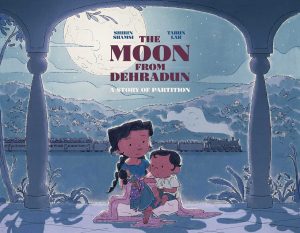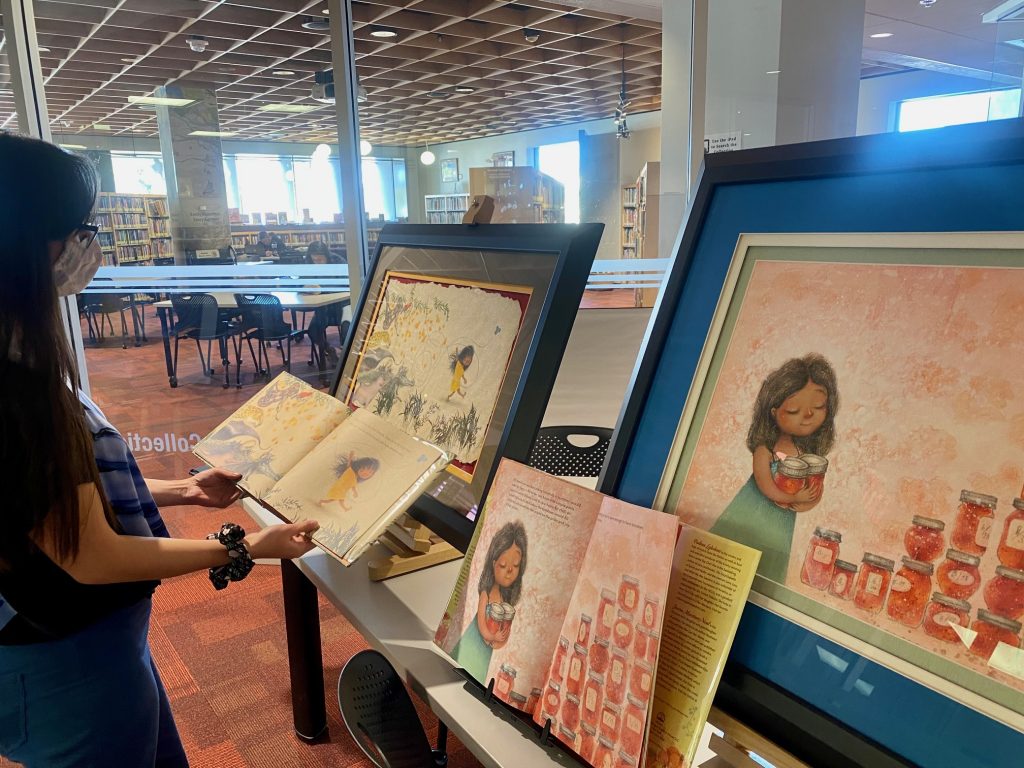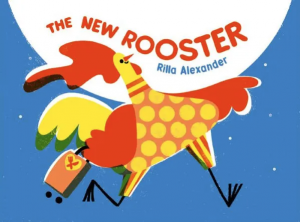 The story in The Moon from Dehradun is based on the history of the 1947 partition that created the individual countries of India and Pakistan. Prior to the partition the region had been a colony of Britain from 1858 to 1947. At the end of their rule the British divided the country according to the majority religions. Muslims must live in Pakistan and Hindus in India. Continue reading
The story in The Moon from Dehradun is based on the history of the 1947 partition that created the individual countries of India and Pakistan. Prior to the partition the region had been a colony of Britain from 1858 to 1947. At the end of their rule the British divided the country according to the majority religions. Muslims must live in Pakistan and Hindus in India. Continue reading
Author: Rebecca Ballenger


WOW Dozen: Picturebook Biographies of Musicians
By Janelle Mathis, North Texas University
In a recent study that examined picturebook biographies of musicians, I was interested in what they offered young readers about the value of music in the lives of these individuals. Shared in a recently submitted article, I discovered over 40 biographies that spanned across historical eras, forms of music, ages of musicians and how music impacted individuals which often was the focus of the picturebook. Books were read and reread revealing themes of offering hope and comfort, creating identity, sharing tradition, giving voice to marginalized people and sharing examples of determination, persistence and strength. Below, are a dozen titles that reflect the challenges and successes of musicians in narratives that provide young readers with new insights to the significance of music in these lives and the potential influences in their own lives. Continue reading

WOW Center Launches Reading-Focused Podcast Centering Youth Voices
The Worlds of Words Center at the University of Arizona College of Education launched a new podcast called “WOW Reads” that centers the voices of teens and pre-teens around literature for young people. The podcast, which currently has four episodes of about 15 minutes each and a bonus episode, features WOW Center Reading Ambassadors discussing books after having met the authors of those books.

Worlds of Words Center Receives Large Donation of Art from Mary J. Wong
by Rebecca Ballenger, Associate Director of Worlds of Words Center
Mary J. Wong, renowned collector of art and signed, first-edition children’s picturebooks, donated sixteen original picturebook illustrations to the Worlds of Words (WOW) Center of Global Literacies and Literatures in the UArizona College of Education. The donation includes works from some of the most notable children’s picturebooks published in recent years – including art by illustrators attending the Tucson Festival of Books.

WOW Center staff member, Aika Adamson, sets up display of Juana Martinez-Neal illustrations that are part of a new donation from Mary J. Wong.

WOW Dozen: Books on Schools and Schooling
By Janine Schall, The University of Texas Rio Grande Valley
Children around the world go to school, but the ways they do so and what happens once they arrive appears very different in diverse places. No matter what it looks like, schools are places of friendship, growth and learning for most children, but they are also situated in a political and cultural context that is worthy of exploration. Continue reading

The Whole World on One Page: International Wimmelbooks
By Rebecca Ballenger, Associate Director, Worlds of Words Center
A thousand stories await discovery on every page of a wimmelbook: Where is the girl with the balloon going? And the dog with the bone? Why are those two boys wrestling? In 1968, Ali Mitgutsch created his first wimmelbook in Germany, Rundherum in meiner Stadt (All Around My Town), and since then these picturebooks have become a regular presence in many children’s libraries. For a limited time, Arizonans can take in The Whole World on One Page: International Wimmelbooks at the Worlds of Words Center of Global Literacies and Literatures (WOW) in the UArizona College of Education.

WOW Dozen: Cousin Love
by Mary L. Fahrenbruck, New Mexico State University, Las Cruces, NM and Violet Henderson, New Mexico State University, Las Cruces, NM
At the 2022 Latinx Kitlit Book Festival, one of the featured authors mentioned the power and sanctity of “cousin love.” The audience’s overwhelmingly positive reaction caught our attention and caused us to think about picturebooks and young adult novels that featured the special bond between cousins.
Drawing from personal memories about the unique connections we share with our own cousins, we selected picturebooks and young adult novels that highlight the complex family relationships that develop across time and place. These texts highlight the creative ways that cousins sustain their bonds through various forms of communication from letter writing to social media, and gap the distances through visits by car and air travel. Continue reading

Books for Exploring the Dignity of the Non-Human World
Holly Johnson, University of Cincinnati, Cincinnati, OH
 The environment has become a critical issue for a majority of people around the world. There are a number of ways to address the issue, and one of those ways is through an eco-cosmopolitan perspective. Eco-cosmopolitanism is “an attempt to envision individuals and groups as part of planetary ‘imagined communities’ of both human and nonhuman kinds” (Heise, 2008, p. 61). In children’s literature, we often get the perspective of an animal or insect. From Peter Rabbit (Potter, 1999) to Watership Down (Adams, 2014) to Charlotte’s Web (White, 2012) to more current texts such as Alice’s Farm (Wood, 2020) and Pax (Pennypacker, 2019), readers are delighted by the antics and/or adventures found within these marvelous examples of non-human creatures interacting in the world. Humorous tales such as the two Skunk and Badger stories (Timberlake, 2020; 2021) make us laugh, while Pax (Pennypacker, 2019), Pax Journey Home (2021) and Charlotte’s Web (White, 2012) can develop empathy for the living things outside the “human” realm. Continue reading
The environment has become a critical issue for a majority of people around the world. There are a number of ways to address the issue, and one of those ways is through an eco-cosmopolitan perspective. Eco-cosmopolitanism is “an attempt to envision individuals and groups as part of planetary ‘imagined communities’ of both human and nonhuman kinds” (Heise, 2008, p. 61). In children’s literature, we often get the perspective of an animal or insect. From Peter Rabbit (Potter, 1999) to Watership Down (Adams, 2014) to Charlotte’s Web (White, 2012) to more current texts such as Alice’s Farm (Wood, 2020) and Pax (Pennypacker, 2019), readers are delighted by the antics and/or adventures found within these marvelous examples of non-human creatures interacting in the world. Humorous tales such as the two Skunk and Badger stories (Timberlake, 2020; 2021) make us laugh, while Pax (Pennypacker, 2019), Pax Journey Home (2021) and Charlotte’s Web (White, 2012) can develop empathy for the living things outside the “human” realm. Continue reading

WOW Dozen: Korean Books Translated Into English
By HeeYoung Kim, West Texas A&M University, Canyon, Texas
Welcome abroad! This month’s WOW dozen takes readers on a journey to Korea. Each picturebook and novel in this column were originally published in Korea and later translated into English. These titles are written by Korean authors who speak Korean and live in Korea. Rudine Sims Bishop’s metaphor of mirrors and windows for multicultural children’s literature is an an invaluable tenet when reading global children’s literature too. Each book on this list introduces readers to the Korean culture as well as themes around imagination, love, loss and hope. Continue reading

WOW Recommends: The New Rooster
 The New Rooster by Rilla Alexander is a universal and fanciful story about the challenges of communicating when many different languages are spoken. The story starts on the title page when Rooster, clutching his roller bag, parachutes from a plane. He has come a long way for his new job in a new country. We notice on the front endpapers that he has been hired to give the wake-up call at the ZZZ Hotel. But when he crows just as he had back home, no one is aroused. Even when he yells at the top of his lungs no one gets up. Repeated efforts until 3 p.m. fail to get anyone out of bed and the rooster figures he is out of a job. He realizes that he will need a good breakfast if he must make the long journey home. When the delicious smells of his cooking finally arouses the hotel guests they share a breakfast and chat. “They didn’t understand every word they heard, but they tried their best.” The ending will leave smiles on listener’s faces as this book makes a terrific read aloud. Don’t miss the punch line on the back endpapers — “Did you know the Rooster speaks pig latin?” Continue reading
The New Rooster by Rilla Alexander is a universal and fanciful story about the challenges of communicating when many different languages are spoken. The story starts on the title page when Rooster, clutching his roller bag, parachutes from a plane. He has come a long way for his new job in a new country. We notice on the front endpapers that he has been hired to give the wake-up call at the ZZZ Hotel. But when he crows just as he had back home, no one is aroused. Even when he yells at the top of his lungs no one gets up. Repeated efforts until 3 p.m. fail to get anyone out of bed and the rooster figures he is out of a job. He realizes that he will need a good breakfast if he must make the long journey home. When the delicious smells of his cooking finally arouses the hotel guests they share a breakfast and chat. “They didn’t understand every word they heard, but they tried their best.” The ending will leave smiles on listener’s faces as this book makes a terrific read aloud. Don’t miss the punch line on the back endpapers — “Did you know the Rooster speaks pig latin?” Continue reading


